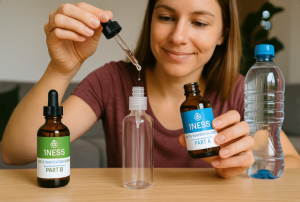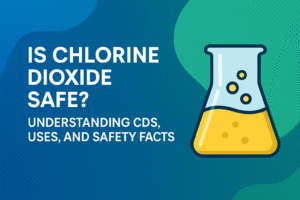When treating water with chlorine dioxide, your choice of activator Citric Acid or Hydrochloric Acid can affect taste, convenience, and user preference. While both options safely activate Sodium Chlorite to produce chlorine dioxide for effective water purification, they each offer distinct benefits.
Let’s explore how these two chlorine dioxide activators differ—and help you decide which is best for your water treatment needs.
Why Are There Two Chlorine Dioxide Activators?
Historically, Citric Acid gained popularity because of its accessibility. Found in most health food stores and used as a natural disinfectant, citric acid became the default choice for many individuals treating water at home or on the go.
Hydrochloric Acid, although equally effective, was once harder to access for everyday consumers. Previously reserved for industrial or chemical use, it’s now available in safe 4–5% concentrations, making it a rising favorite due to its cleaner taste and natural compatibility with the human digestive system.
Citric Acid: The Original Go-To Activator
Widely available and easy to store
Trusted by long-time chlorine dioxide users
Offers a noticeable taste, sometimes perceived as stronger
Derived from natural sources and frequently used as a food-safe disinfectant
Many users remain loyal to citric acid because they’re familiar with it and appreciate its effectiveness.
Hydrochloric Acid: A Cleaner-Tasting Alternative
- Occurs naturally in your stomach, making it biocompatible
- Low residual taste, preferred by those sensitive to flavor
- Effective at safely activating sodium chlorite at 4–5% concentrations
- Now widely used in emergency preparedness and professional purification kits
Some users report Hydrochloric Acid feels milder on the stomach, possibly due to its presence in human digestive systems.
Learn more about chlorine dioxide activation from PubChem.
Do They Work the Same?
Yes! Both activators achieve the same chemical result—producing chlorine dioxide to safely disinfect and purify water. The main difference lies in taste and availability.
Some users perceive Citric Acid as stronger-tasting, while others prefer Hydrochloric Acid for its neutral finish.
Which Should You Choose?
Choose Citric Acid if you:
- Are accustomed to its flavor
- Want a natural option that’s easy to find and store
- Prefer a tart, acidic note in your solution
Choose Hydrochloric Acid if you:
- Prefer a milder, less noticeable flavor
- Want a more neutral and biocompatible activator
- Are using chlorine dioxide regularly and want a smoother experience
No matter which you pick, both activators are safe, effective, and available at 1NESS in high-quality formulations.
Ready to Purify Your Water the Safe Way?
Choose your preferred activator and take control of your water safety:
Shop Chlorine Dioxide Activators Here
Frequently Asked Questions (FAQs)
Q1: Is Hydrochloric Acid safe to use as a chlorine dioxide activator?
A. Yes, when used at proper concentrations (like 4%–5%), Hydrochloric Acid is safe and effective. It’s also naturally present in your stomach to aid digestion.
Q2: Does Citric Acid make a stronger solution than Hydrochloric Acid?
A. The end result is chemically the same—chlorine dioxide. However, Citric Acid may leave a stronger taste, which some users associate with strength.
Q3: Can I use both activators interchangeably?
A. Yes. As long as you follow the correct activation ratios, you can use either Citric Acid or Hydrochloric Acid to generate chlorine dioxide safely.
Q4: Which activator is better for sensitive stomachs?
A. Many users with sensitivities prefer Hydrochloric Acid, as it’s gentler and more naturally compatible with the digestive system.
Q5: Where can I purchase both activators?
A. Both are available directly from 1NESS at: onenessdrops.com/shop




